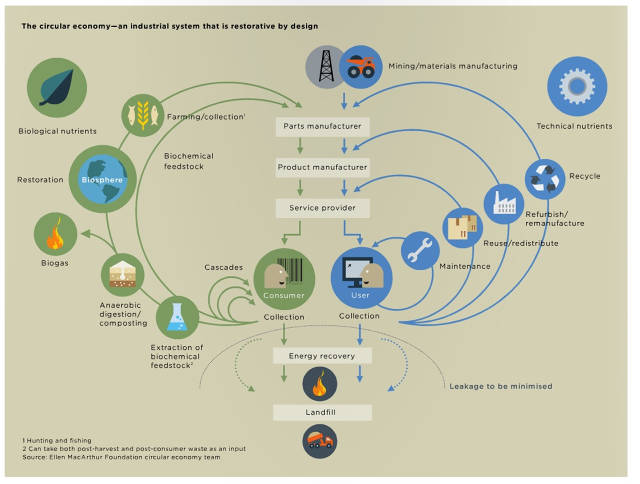Circular Future views the circular economy as the way forward for our economy. Implementing circular business models creates new jobs, generates substantial financial gains, saves resources and reduces environmental impacts. It can strengthen our economy with 3 million jobs for the EU alone and offers global business opportunities worth trillions of euros. The capacity of a circular economy to reduce environmental impacts, to which Circular Future attaches high value, follows from the business models. For this reason, it can be viewed as a collateral benefit of a superior economic model.
This will help to make our economy sustainable. Politicians are looking for a “new, compelling story” for the future. According to Circular Future, it is this: business has exceeded the planetary boundaries. Governments must urgently create a new regulatory framework that enables companies to operate within these boundaries.
The ambition of Circular Future is to accelerate and guide the transition to a circular economy. Based on Arthur ten Wolde’s experience with public affairs and knowledge of the circular economy, we advise governments and companies on how to formulate and implement policies to accelerate circular business models. Unifying, disrupting where necessary, always with a perspective on the future.
The key to reaping the fruits of the circular economy for companies lies in a switch to circular business models. We have developed a new tool for this that is described in the report Circular Business Models (2015). The transition concerns business models, models for procurement, investment and other financial models within companies, governments and other organizations, and also includes circular design.
Time after time, the financial argument eventually determines the choice to not opt for circular.The key to upscaling into a circular economy therefore lies in a systems change by using financial incentives from governments to business and consumers. This means price incentives, set or authorized by the government. National, provincial and local authorities can give a huge boost to the circular economy by acting as launching customer for circular products and services. By public procurement, adapting the tax system and introducing levies based on external producer responsibility. Besides price incentives, much more is needed, such as enforcement, awareness raising and adapting various laws and regulations. Setting targets and measuring progress is crucial. For a detailed analysis see the Business Manifesto “More prosperity, new jobs” (2015). Finally, following the examples of sustainable leaders such as the Ecopreneur.eu members, companies can already do much more themselves by switching to circular procurement and business models in the current linear system.
Circular Future embraces the Ellen MacArthur Foundation’s view of a circular economy as “an industrial system that is restorative or regenerative by intention and design. It replaces the ‘end-of-life’ concept with restoration, shifts towards the use of renewable energy, eliminates the use of toxic chemicals, which impair reuse, and aims for the elimination of waste through the superior design of materials, products, systems, and, within this, business models” (EMF, 2012).

Source: Ellen MacArthur Foundation, 2012
Besides jobs and business opportunities, resource scarcity is one of the drivers for creating a circular economy. For many materials, security of supply and the risk of unpredictable price fluctuations are increasing issues despite the existence of sufficient physical stocks or reserves. While mineral resources never run out completely, economically recoverable reserves will sooner or later become depleted, especially regionally.
For more information on our services click here.